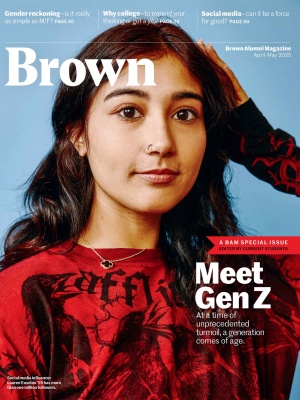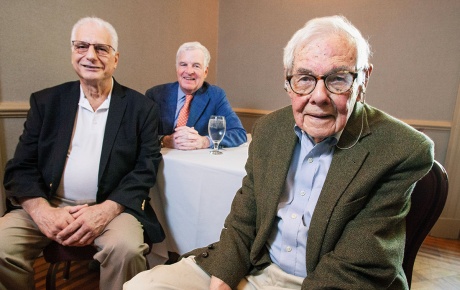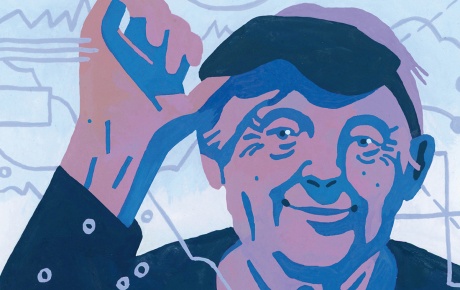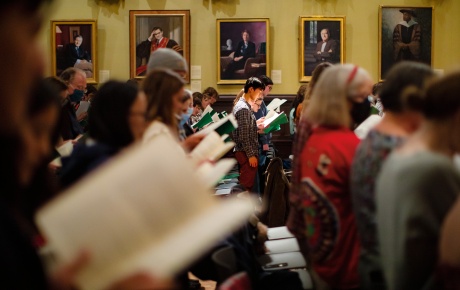When physicist Leon Cooper came to Brown in 1958, he had already made one of the great breakthroughs in his field, establishing the mechanism behind superconductivity. Scientists had known for decades that certain metals cooled to extremely low temperatures acquired the ability to conduct electricity without any resistance, creating strong electromagnetic fields with minimal energy loss. Giants of physics—including Einstein, Heisenberg, Bohr, and Feynman—had tried and failed to explain how that could be. While still in his 20s, Cooper proposed a simple and elegant solution that happened to work. Named BCS theory after Cooper and two colleagues, John Bardeen and Robert Schrieffer, it earned him the 1972 Nobel Prize, assuring his reputation as a giant of physics himself.
By that time, however, Cooper had already moved on to a new field—neuroscience, where he spent the next 50 years making new seminal discoveries. He died this past October 23 at age 94. “The fact he was able to make significant discoveries in that field was amazing to me,” says Brown physics professor Jim Valles. “This was not something he just dabbled in after he got the Nobel, but he really became master of it.” In remembering Cooper, Valles is one of many Brown colleagues who praises Cooper’s insatiable curiosity, wit, and clever ability to solve problems in disparate fields. “The easy decision would have been for him to continue what he knows, the theory of electrons, but obviously he needed a new challenge,” says physics professor Sean Ling. “That really required courage—and it really paid off.”
In an essay, Cooper himself explained the reason for the change with characteristic wit: “The best I can come up with is to repeat Humphrey Bogart’s response to Claude Rains in Casablanca: ‘I was misinformed.’” Initially, Cooper surmised that his theories on electrons could be applied equally to neurons. While that method didn’t pan out, however, his novel approach to neuroscience starting with theory rather than observation led to an essential discovery about how synaptic connections in the brain are reinforced to facilitate memory and learning.
Born Leon Kupchik to immigrant parents from Belarus and Poland, Cooper showed an early passion for physical sciences—so much so that he nearly blew up a closet while mixing chemicals in his Bronx home at age 12. After graduating from Bronx High School of Science and Columbia University, he began his career in high energy physics at Princeton before Bardeen recruited him to the University of Illinois–Urbana-Champaign to work on the superconductivity problem. At the time, physicists had a vivid picture of electrons bouncing through the lattice of a wire to conduct electricity. No matter how much they tweaked their model, however, they couldn’t explain how that bumping around stopped at extremely low temperatures.
New to the field of solid-state physics, Cooper proposed an entirely different solution, identifying how pairs of unstable electrons could form weak bonds across the lattice, allowing them to glide effortlessly through the wire, even when they were separated by millions of particles in between. “Cooper pairs,” as they came to be known, became the basis for understanding superconductivity, ultimately enabling everything from fMRI machines to quantum computing.
“He managed to take something that was so complex and intractable and make it so simple,” says physics Professor Dmitri Feldman, who co-edited a book with Cooper on the 50th anniversary of BCS theory. “People had dismissed it, because the interaction is so weak, but he was able to think outside the box. Big discoveries always take a completely different way of looking at the problem.”
A lover of fine art and French wine, Cooper displayed a broad-minded approach to science, combining elements of philosophy and art in his explanations of the universe. His 1968 book The Structure and Meaning of Physics used an imaginative and poetic approach to explaining essential principles of physics, making it accessible to people of all levels. At Brown, he pioneered an innovative introductory physics class alongside Trinity Rep artistic director Oskar Eustis, political scientist Tom Beirsteker, and history professor Tom Gleason that explained concepts using the play Copenhagen, about the meeting of great physicists on opposite sides of World War II. “Instead of presenting physics as a set of dry facts and equations that described how the world works, he emphasized that it was a human creation that could and should be appreciated for its aesthetic beauty,” Watson Institute communications specialist Pete Bilderback, who worked with Cooper for 20 years, wrote in a remembrance.
Cooper founded the Center for Neural Science at Brown in 1973 with interdisciplinary faculty from physics, mathematics, biomedical sciences, and linguistics, as he set himself the task of understanding a paradox in how the brain learns. Neuroscientists have long known that connections between neurons across synapses are reinforced the more they are used; the problem was that over time, those synapses would eventually become saturated, losing the ability to store information.
Cooper theorized that synapses were bi-directional and could be both weakened and strengthened depending on use; crucially, he proposed, the threshold for those adaptations also shifted with use, becoming harder to change the closer a neuron got to saturation, so it never got there completely. “Leon’s theory had a big impact. There are some great examples of theoretically inspired experiments in neuroscience, but they are rare,” says Mark Bear, neuroscience professor in the Picower Institute for Learning and Memory, who helped collaborate with Cooper on experiments proving his theory. “It was in the physics tradition of theoreticians coming up with a potential solution and then experimentalists going back to the bench and saying, ‘Let’s test these assumptions.’”
Despite Cooper’s stature in physics, Bear found him humble in approaching their collaboration. “He respected others for what they knew, and didn’t make you feel inadequate for what you didn’t know,” he says. “When it came to biology, he was an eager student of mine.”
Those who worked with him describe him as an enthusiastic mentor to junior colleagues who was always willing to give a speech for incoming students or graduates, coming up with an original talk every time. Current physics chair Vesna Mitrovic remembers him being generous with his time in reviewing her own early research on superconductivity, years after he had switched fields. “We had quite a few discussions on papers I was writing early on,” she says. “It was nice to hear him say, ‘Let me think about it,’ and then days later come back and say, ‘I thought about it, and I couldn’t find anything wrong with the interpretation.’”
Survived by his wife Kay, daughters Coralie and Kathleen, and four grandchildren, Cooper continued to rack up awards throughout his career, including receiving the 2013 Susan Culver Rosenberger Medal, the highest honor Brown faculty can bestow. Perhaps his quirkiest honor was having Sheldon Cooper, protagonist of the science-y sitcom The Big Bang Theory, partially named after him. Even after he retired from teaching in 2014, Cooper still returned regularly to the Barus & Holley buildings to inspire colleagues with both his knowledge and joie de vivre. “Every day when he walked by, he said hello with a big smile,” remembers Ling. “He was just an immense presence on the seventh floor—I feel a very big void in his absence.”





